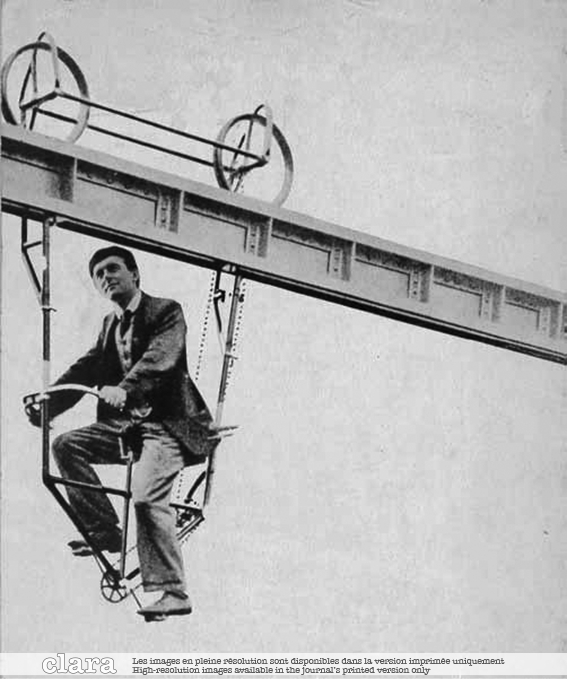Walking, the marketing of the body
Main Article Content
Abstract
The Situationists, and later Michel de Certeau, saw in the city "through walking" that which would escape all projection and predetermination: the (psychogeographical) drift, the repressed of the city, its unrepresentable, its very practice which distances it from any totality, demultiplying it. Walking inspired these great thinkers of (post)modern and urban society, as it had done a century earlier for the first of them, Baudelaire. Another contemporary of the 1950s and 1960s, the British architect Brian Richards, brought walking back into the mainstream of progressive and futuristic thinking for a whole generation, by outlining the technologies for improving the mobility of this new user of the city, and for transforming the city itself into a fluid movement.
Article Details

This work is licensed under a Creative Commons Attribution-NonCommercial-NoDerivatives 4.0 International License.
References
AMAR, G. 2010. Homo mobilis. Du transport urbain au nouvel âge de la mobilité, Paris, éditions fyp, 2010.
ARTH, M. E. 2008. New Pedestrianism, consultable en ligne, lien url: www.MichaelEArth.com.
BENGT, K. 2008. «La santé en marchant?», Urbanisme, n° 359, mars-avril, p. 55-56.
BOILEAU, N. 1666. «Les embarras de Paris», Les Satires, s.i. s.é.
CHARDONNET-DARMAILLACQ, S. 2011. «“such”, Sentiers Urbains, Connexions & Hub: enjeux d’une infrastructure de marche à Paris», dans D. Rouillard (sous la dir. de), L’infraville. Futurs des infrastructures, Paris, Archibooks, p. 149-158.
CROSBY, T. 1965. Architecture: City Sense, Londres, Studio Vista.
FERRISS, H. (1929) 1987. The Metropolis of Tomorrow, trad. La métropole du futur, Paris, Centre G. Pompidou.
HÉNARD, E. 1982. Études sur les transformations de Paris (1903-05), Paris, L’Équerre.
LAVADINHO, S.; LÉVY, J. 2010. «Marcher avec les transports et la ville», ProSpective, RATP / EPFL, n°160.
LAVADINHO, S.; WINKIN, Y. 2008. «Du marcheur urbain», Urbanisme, dossier spécial «Marcher», n° 359, mars-avril, p. 43-49.
LE CORBUSIER, (1946) 1972. Manière de penser l’urbanisme, Paris, Denoël / Gonthier.
LÉVY, J. 2008. «Ville pédestre, ville rapide», dans Urbanisme, dossier spécial «Marcher», n° 359, mars-avril, p. 56-59.
OFFNER, J.-M. 2008. «Trente ans de pas perdus!», Urbanisme, dossier spécial «Marcher», n° 359, mars-avril, p. 56-59.
ROUILLARD, D. 2004. Superarchitecture. Le futur de l’architecture 1950-1970, Paris, La Villette.
ROUILLARD, D. 2007. «“La ville à dix minutes”. La distance de temps dans la théorie de la ville mesurée», dans C. Prelorenzo et D. Rouillard (sous la dir. de), Le temps des infrastructures, Paris, L’Harmattan, 2007, p. 11-22.
ROUILLARD, D. (sous la dir. de) 2009. Imaginaires d’infrastructure, Paris, L’Harmattan.
ROUILLARD, D. 2011. «Future was back», dans A. Guiheux (sous la dir. de), Action Architecture, Paris, Les Éditions de La Villette, p. 23-47.
RICHARDS, B. 1966. New Movements in Cities, London, Studio Vista.
RICHARDS, B. 1968. «Minisystems in the City», Architectural Forum, janv-fév. p. 98-105.
RICHARDS, B. 1971. «Personal rapid transport. The Horizontal “Elevator”», Architectural Design, Juin.
RICHARDS, B. 1976. Moving in Cities, Boulder (Colorado), Westview Press.
RICHARDS, B. 1990. Transport in Cities, London, Architecture, Design and Technology Press.
RICHARDS, B. 2001. Future Transport in Cities, London, Spon Press.
ROJEY, A. 2008. Énergie et climat. Réussir la transition énergétique, Paris, Technip.
TERTRAIS, B. 2011. L’apocalypse n’est pas pour demain, Paris, Denoël.
US DEPARTMENT OF HOUSING AND URBAN DEVELOPMENT, 1968. Tomorrow ‘s Transportation. New Systems for the Urban Future, Washington DC, US Department of Housing and Urban Development.
WOLF, P. 1974. The Future of the City. New Directions in Urban Planning, New York, Whitney Library of Congress.

